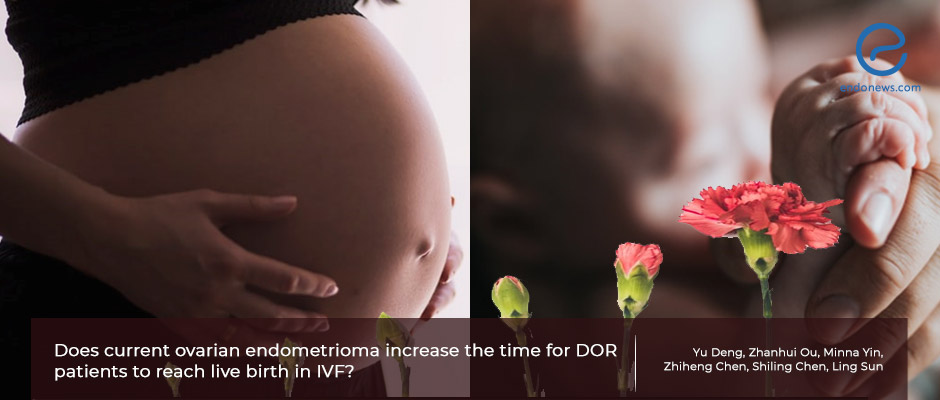Does endometrioma affect ovarian reserve to reach pregnancy and birth?
Jun 21, 2022
The presence of endometrioma does not have any significant effect on “time to live birth” in women with diminished ovarian reserve.
Key Points
Highlights:
- Women with poor ovarian reserve and endometrioma should be aware that the presence of endometrioma may not negatively affect their pregnancy.
Importance:
- There is no need for endometrioma surgery prior to IVF treatment in women with endometrioma and diminished ovarian reserve.
What’s done here?
- A retrospective case-control study was conducted on the patients who underwent in vitro fertilization (IVF) treatment due to poor ovarian reserve.
- Serum anti-Mullerian hormone (AMH) level below 1.1 ng/mL was defined as "abnormal ovarian reserve" referring to Bologna criteria.
- The study population was divided into two based on the presence of endometrioma; group A: with a diagnosis of endometrioma, and group B: having neither current nor a history of endometrioma.
- The demographical and clinical characteristics and IVF outcomes of the patients were compared between the groups.
- The participants achieving live birth were also sub-analyzed depending on the presence of endometrioma: group A1: had endometrioma (n=31) and group B1: had no endometrioma (n=132).
- Cumulative live birth rate and time to achieve live birth were the main outcome measures.
Key results:
- A total of 493 patients met the eligibility criteria and were included in the study [Group A (n=90), Group B (n=403)].
- The age, BMI, infertility duration, antral follicle count, serum AMH, follicle-stimulating hormone (FSH), luteinizing hormone (LH), and estradiol (E2) basal levels were NOT different.
- Serum AMH levels were significantly lower in group A1 compared to B1.
- All laboratory parameters were comparable between the groups (mean oocyte pick-up cycles, embryo transfer cycles, numbers of oocytes retrieved, 2 pronuclear zygotes, embryos, and good-quality embryos per patient and per cycle).
- Implantation rate, live birth rate, and total time to achieve live birth did not show significant differences between A1 and B1.
Strengths and Limitations
- The retrospective design, small sample size, and different reasons for diminished ovarian reserve could be accepted as the limitations of the study.
- A large spectrum of endometrioma including painful symptomatology, size, and laterality of endometrioma should also be taken into account as the limitation.
Lay Summary
Endometrioma occurs in approximately 17-44% of women with endometriosis. These women suffer from dysmenorrhea, dyspareunia, chronic pelvic pain, and also infertility. Although the exact mechanism explaining endometriosis-associated infertility has not been elucidated, distorted pelvic anatomy, impaired ovarian function, altered microenvironment-endometrial receptivity, and embryo quality has been accepted as the most common responsible mechanisms.
In vitro fertilization treatments can be performed for the management of infertility in women with endometrioma. It has been known that clinical pregnancy and live birth rates were comparable, even with fewer oocytes and MII oocytes retrieved and fewer embryos formed in women with endometriosis compared with healthy women.
Deng et al. from China, published a study entitled “Does current ovarian endometrioma increase the time for DOR patients to reach live birth in IVF?” in the journal "BMC Pregnancy and Childbirth".
The authors aimed to evaluate whether there was a difference in “time to live birth” in women with endometrioma and diminished ovarian reserve. They conducted this study on the patients who underwent in vitro fertilization treatments. All outcome measures were evaluated by comparing women with and without endometrioma. “Time to live birth” was also analyzed among those who became pregnant. All laboratory parameters were comparable between the groups regarding the mean number of oocyte pick-up cycles, embryo transfer cycles, numbers of oocytes retrieved, 2 pronuclear zygotes, embryos, and good-quality embryos per patient and per cycle. Implantation rate, live birth rate, and total time to achieve live birth did not show significant differences between the groups.
“For women with diminished ovarian reserve, the presence of endometrioma did not affect the IVF outcomes of multiple cycles. Even the time to live birth was not prolonged by current endometrioma” the authors concluded.
Research Source: https://pubmed.ncbi.nlm.nih.gov/35428243/
ovarian endometriomas diminished ovarian reserve in vitro fertilization cumulative live birth rate time to achieve live birth

